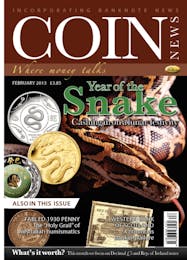Too much of a good thing?
IT has come to our attention that the Bank of Canada has recently returned almost 250,000 gold 5 and 10 dollar coins to the Ottawa Mint (now of course the Royal Canadian Mint, the RCM), apparently they were part of the country’s gold reserve put down in 1912, 1913 and 1914 and thus are dated from those years. They have remained in the Bank’s vaults all these years as they were not needed and now, in a deal worked out late last year with RCM, they have come onto the open market. These coins, which were the very first of Canada’s own style gold coinage (they used English sovereigns before 1912) which feature the George V’s effigy with Canada’s arms within maple leaves on the reverse have now been “slabbed” by NGC and sold by RCM at a substantial profit, with prices ranging from $500 for one coin to $12,000 for a set of 6 (one of each date 5 and 10 dollar). Now initially collectors of Canadian coins may consider this to be a good thing, after all suddenly hitherto impossible to own coins are within the reach of many and surely that’s a good thing for the hobby isn’t it? Surely more people able to complete their collections can only be good for numismatics, can’t it? Apparently not, as many collectors are up in arms at the RCM’s decision to release these coins, having paid upwards of $2000 for those coins previously on the market. Now with thousands more out there (they have all already been sold) what will happen to the value? We all know that the price of coins, indeed most things, is directly related to supply and demand so with a sudden new supply hitting the market and the demand unlikely to match pace it is unlikely that these coins will go back to their previous value for some time, and of course there is the danger that there are even more coins out there in vaults—and if not coins of these dates perhaps there are others soon to be available? And what if the Canadian banks are not the only ones with such treasures in their possession? What if there are other coins just waiting to come to light in the US? In Europe? In Britain? What will that do to prices?
Some years ago we visited the Debden Security Printing plant in Loughton, Essex and were privileged enough to be able to witness the presses that printed Bank of England notes—and whilst that was very impressive we were also struck by the fact that not only were notes printed there but they were also disposed of there too. Any notes that come in to high street banks, whether tatty tenners printed last year and put through the wash or crisp white fivers printed last century and hidden in a bureau are exchanged for face value then sent to the Bank of England to be destroyed. At first we were horrified by this, believing that any historically important notes should be offered to collectors rather than burned or shredded but now maybe we aren’t so sure. After all if notes were routinely sent into the collector market from the bank then what would that do to prices? Undoubtedly much the same as has happened in Canada . . . Collectors of Roman, Celtic or Anglo-Saxon coins have always recognised this problem, knowing full well that they could pay a premium for one rare coin only for a hoard to come to light some time in the future, it is a hazard of such a collection and one that is left to chance—when the banks and mints start actively flooding the market, well that is a different story.
This of course begs the question—should we care more about the items themselves or their value? Should we be rejoicing in new finds and encourage banks and Mints to release any stockpiles they may have so that more collectors can enjoy the pleasure of ownership? Or actively encourage them not to? Trying instead to convince them to keep their treasures to themselves, or even destroy them so that values can be maintained? It’s never an easy decision to make—we are all numismatists, keen to encourage others to collect and happy to help others achieve their dream but we are also realists and few of us would be happy spending the hundreds, if not thousands, of pounds we may have had to get our collections to where they are if we thought we were going to lose all that money! There is no easy answer and your position probably depends on whether you are the person who already owns a 1912 10 dollar piece, obtained at a cost, or the person now able to afford one because there are lots more around!

Archives
-
2024 (16 articles)
-
2023 (55 articles)
-
2022 (44 articles)
-
2021 (59 articles)
-
2020 (80 articles)
-
2019 (50 articles)
-
2018 (49 articles)
-
2017 (46 articles)
-
2016 (54 articles)
-
2015 (44 articles)
-
2014 (62 articles)
-
2013 (75 articles)
-
2012 (74 articles)
-
2011 (81 articles)
-
2010 (131 articles)
-
2009 (91 articles)
-
2008 (89 articles)
-
2007 (75 articles)
-
2006 (76 articles)
-
2005 (19 articles)
-
2004 (11 articles)
-
2003 (23 articles)
-
2002 (16 articles)
-
2001 (11 articles)









